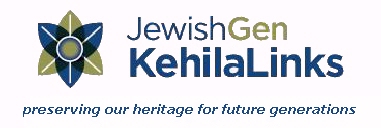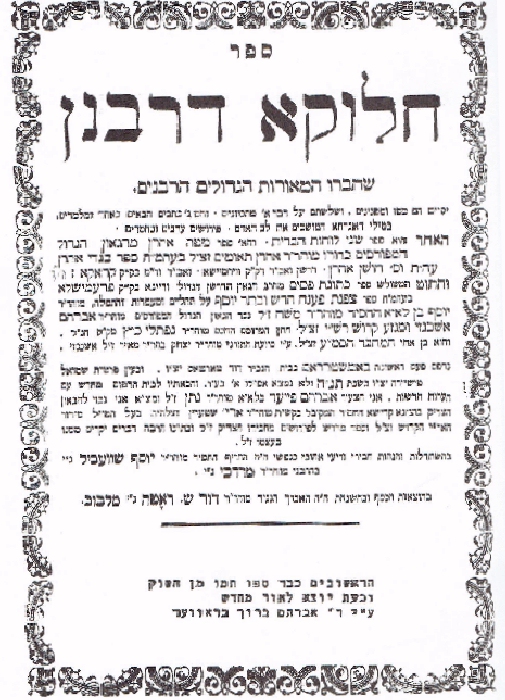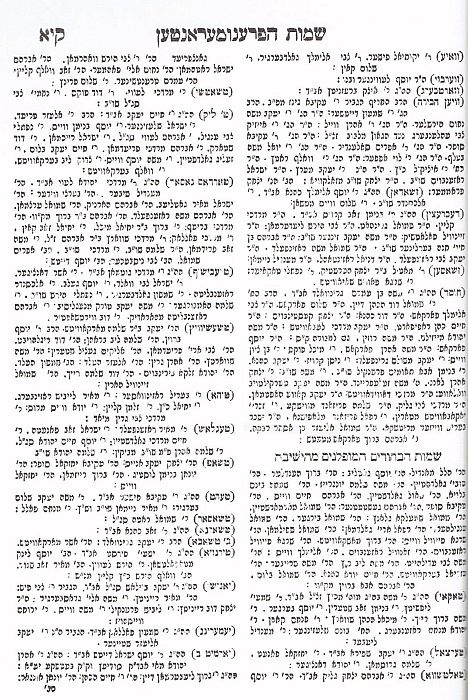| Khust Religious |
| ~ Religious Life ~ |
|---|
| The Jewish community of Khust was one several large, cohesive and organized communities in the Carpathian region. Community life centered primarily around the synagogues, the batri midrash, the yeshivas (Torah academy) and the cheders (houses of learning). There was a mikvah (ritual bath) and a building for schochets (ritual slaughterers). |
| Khust was blessed with rabbinic geniuses in Talmudic and other religious learning - gaonim (places of eminent wisdom and knowledge of the Talmud). They were all-absorbed in Torah, wrote books and had authoritative status. The rabbis of Khust were well known throughout the Jewish world, beginning with the foundation of the yeshiva. Rabbi Menachem ASH, from Eisenstadt, was the last generation of rabbis. His yeshiva was like a magnet to hundreds and thousands of Torah students throughout the Hungary and Czechoslovakia. It was one of the cultural cornerstones of the city's young people. Khust yeshivas produced tens, maybe hundreds of rabbis and thousands of talmudic chachamim (Torah scholars). Torah life in Khust was highly developed, even in comparison with the Hungarian empire and the Czech Republic. The rabbis of Khust could not be identified with active Hassidism, although they did have some connection to Hassidism. The Grand Synagogue in Khust was perhaps the only one in the entire region where the prayers were Ashkenaz. After WWI, two religious schools of thought could be observed - the Hassidism vs. the Mitnagim (????). In addition to the , the community maintained a Talmud Torah (elementary school) with a number of chadirim (classes/grades). |
| In summary the majority of the Khust Jews were not subject Hassidic influence, although the city was surrounded by villages in which Hasidim ruled. The mentality that old-time baalai batim (heads of households), some of whom were Torah scholars, was closer to that of central Hungarian Jews. The number of Hassidim steadily increased between the two world wars. The larger group belonged Satmar-Segget sect. Their Beit Midrash (house of learning), which actually served as a synagogue (Etz HaChaim), was second only to the Great Beit Midrash. Despite the existing tension born of the membership and one versus the other religious group, community life functioned in a cohesive and unified way. The representatives of all groups and factions, with their different outlooks, all cooperated running the community. |
| ~ Chief Rabbis of Khust 1812 - 1944 ~ |
|
|---|---|
| In the early 19th century, the community was given the right to choose a rabbi and the first rabbi was Rabbi Yaakov, from Zydaczow. |
|
| It is mentioned on the gravestone of Rabbi Yaakov bar Avraham that he was the first rabbi of Khust, from 1812 to 1823. He was born in Zsidichov and was a descendent of Rabbi Shmelke of Nikolsburg. He traveled to Brid to speak before the congregation on the laws of Passover and it was thre he passed away. He is buried in Brid and many used to come to pray at his grave. |
|
| The next Chief Rabbi of Khust was Rabbi Yaakov GOTTLIEB, from Tokai. Rabbi GOTTLIEB was a Torah gaon (known for his eminent wisdom and knowledge of the Talmud). He served in Khust between the years 1823 and 1845, when he left for Bihar Nagybojom, where he died in 1860. |
|
| From 1845, one of the greatest rabbis headed the rabbinate, the gaon Rabbi Menachim bar Mier ASH (EISENSTADT). He founded the the in Khust and invested much effort in making it successful. Rabbi ASH lived in Khust only seven years, for his father, Rabbi Mier ASH, the rabbi of Uzhhorod (Ungvár), died in 1852 and Rabbi Menachim ASH was called to replace him. Rabbi Menachim ASH died in Uzhhorod (Ungvár) in 1869. |
|
| After Rabbi Menachim ASH (EISENSTADT) left Khust IN 1852, Rabbi Shmelke Bar Yosef KLEIN was chosen for the position. In Hungary, Rabbi Shmelke was known for his tremendous sharpness in Torah learning. He managed to make the great, in quantity and quality. In 1861, he was chosen as the Rabbi of Vynogradiv (Nagyszőllős/Sevluš) and he left Khust. He was since known as Rabbi Shmelke of Sevluš and he passed away in 1875. |
|
| The rabbi who, more than any other, left his mark Khust community, and on Hungary in general, was Rabbi Moshe bar Yosef SHICK, known as the "Maharam Shick." He was born in 1807 in Berezovo in the Nitra region. Besides being of outtanding intellectual ability, he absorbed Torah and knowledge in the Hatam Sofer's in Pressburg (Bratislava). He embarked on his rabbinical path in Yergen, where he established a . After the office of Chief Rabbi in Khust became available, he accepted the community's invitation and in 1861, was appointed Chief Rabbi of Khust. The rabbi's fine reputation and that o the community was well-known throughout Hungary. In 1867, he was among the founders of the Shomrei Hadat Society, out of which Hungarian Othodoxy sprang. "Maharam Shick" died in 1879, and in his will, he recommended that the community choose a rabbi that was greater and more pious than himself, which made it posible to choose a rabbi that was not an offspring of his. |
|
| The next Chief Rabbi of Khust was the gaon Rabbi Amram bar Yitzhak Yaakov BLUM. Since there was no common ground beteen him and some of the Khust community members, he left after a service of merely two years, 1881-1882. |
|
| After he left, the tsaddik Rabbi Yoel-Zvi ROTH ben Rabbi Shimon from Komanda took his place as Chief Rabbi of Khust. When he was 11 years old, Rabbi Yoel-Zvi's father brought him to the Maharam Ash in Uzhhorod (Ungvár) where he studied for seven years until his marriage to the daughter of the gaon Rabbi Yaakov GOTTLIEB. In 1884, the leaders of the Khust Jewish community sought him out and accepted their offer as Chief Rabbi of Khust. He too made the flourish. He died in 1882. |
|
| That year, after Rabbi Yoel-Zvi passed away, the community was fortunate to have the Torah gaon, Rabbi Moshe bar Amram GRÜNWALD in its midst. He was well known throughout Hungary and left his mark on generations to come. He published many books, amoung them Arugot Habosem (The Spice Garden). During his rabbinic term, the in Khust was blessed with many young students of the Torah, who went on to beome rabbis, judges, doctors and lawyers. He died in 1910 at the age of 58. The community experienced a great loss with his passing—he was loved by all from the observant to the non-believers. He is buried on the old Khust cemetery. |
|
| Also in 1910, his son, Rabbi Avraham Yosef GRÜNWALD was appointed Chief Rabbi of Khust. This was the first time in the history of the rabbinate of Khust a son succeeded his father. He was born in 1878. In his term, the number of students in the yeshiva
decreased and things got even wordse during WWI. This state of affairs upset him and he decided to leave his position in 1921 and accepot,the offer made by the Uzhhorod (Ungvár) community to serve as their rabbi. In 1928, he died at the young age of 50. |
|
| In 1921, gaon Rabbi Yosef-Zvi ben Rabbi Yisrael DUSCHINSKY was asked to take over as the Chief Rabbi of Khust. When he came to Khust, tens of students from Galanta came with him. In the second year after his arrival, the numbered 150 students. At its peak, the numbered close to 400 students. Rabbi Yosef-Zvi was liked by all in the Jewish community, even the Zionists whom he strongly opposed. As fate would have it, in 1933 he decided to immigrate to Eretz Yisrael (Israel) and about 80 of his students followed him, thereby fulfilling Zionism in actual practice. He passed away in 1948. |
|
| After Rabbi DUSCHINSKY left Khust, the grandson of the Arugot Habosem, Rabbi Yehoshua ben Rabbi Avraham Yosef GRÜNWALD—who was born in Makó in 1909—was selected as the Chief Rabbi of Khust. During Rabbi Yehoshua's tenure, there were about 150 students studying in the until the Germans took over in in March, 1944. From that point on, the community stopped functioning as one, and the Gestapo setup a Judenrat. Rabbi Yehoshua, his followers and the Khust (and surounding) Jewish communities suffered greatly as a resulty of the Holocaust. Rabbi Yehoshua survied the Holocaust and after the war, he lived in Budapest, then Paris and in 1948, he settled down in Brooklyn, Newy York heading the HaYeraim DeKhust community in Boro Park. He passed away in 1969. |
|
| ~ Khust Admorim (Hassidic Rabbis) and Tzaddikim (Rightous ones) ~ |
|
| During "Maharam Shick's lifetime, the well-known admor Rabbi Mordechai LEIFER of Nadvorno lived in Khust. He did not remain in the city and moved to the neighboring village Bushtyno. |
|
|
After Rabbi Mordechai left Khust, his young son, admor Rabbi Yisroel Yaakov LEIFER, came to live in Khust during his father's lifetime and stayed there for close to 40 years. Rabbi Yisroel Yaakov was known as a man of miracles and people from all parts of the Jewish population came to him for advice or help for their suffering. Even official pharmacies honored his medical prescriptions. Across from his home in the old Cinema Street, there was a synagogue that bore his name. Rabbi Yisroel Yaakov passed away in 1929 and was buried near his father's grave in Bushtyno. Rabbi Yisroel Yaakov's grandson, known as the "Admor of Khust," immigrated from the United States to Israel Eretz Yisroel and continued in his ancestor's way. |
|
| Rabbi ITSHEMIER, admor and cantor (singer of religious prayers) also lived in Khust.
|
|
| In the 1940's, the Rabbi from Lipshe, a tsaddik, settled in Khust. He has many followers and they opened a synagogue in his honor in what was formerly the Hehalutz Hatzair club. |
|
| Rabbi Hezkia GRÜNWALD, a tsaddik, brother of the author of Arugot Habosem, lived in Khust for a few decades until he was taken to Auschwitz, in 1944, and never came back. He was often asked to serve as Rabbi of the neighboring villages and in his great humbleness, he declined. |
|
| Rabbi Moshe ROSENFELD, a tsaddik, also lived in Khust. |
|
| ~ Khust Dyanim (Judges) ~ |
|
| |
| ~ Khust Shochets (Ritual Slaughterers) ~ |
|
| |
| ~ Khust Kehila Roshei (Community Leaders) ~ |
|
| |
| ~ Khust Melameds (Teachers) ~ |
|
| |
|
|
| Sefurim (Religious Books) with Prenumeranten |
|---|
| [ click the image to view a larger image. Ctrl+ enlarges image still further ] |
|
| ~ Khust Synagogue ~ |
|---|
|
|
|
| ~ Khust Synagogue Photo Album ~ |
|---|
| Below, there is a slideshow album for your viewing. |
| Click the photograph to start the slideshow Click the arrows to move through the show: |
|
|
| This page is hosted at no cost to the public by JewishGen, Inc., a non-profit corporation. If you feel there is a benefit to you in accessing this site, your JewishGen-erosity is appreciated. |
| Created and Compiled by: Marshall J. KATZ, USA with assistance from: M. Y. EHRENREICH, USA Amos Israel ZEZMER, France and the following: JewishGen members/descendants and contributors of Khust Jewish families: Shlomo KATZ, USA |
| Updated: 09 October 2020 |
| Copyright ©2013 Marshall J. Katz All rights reserved |
 |
Top of Page |





